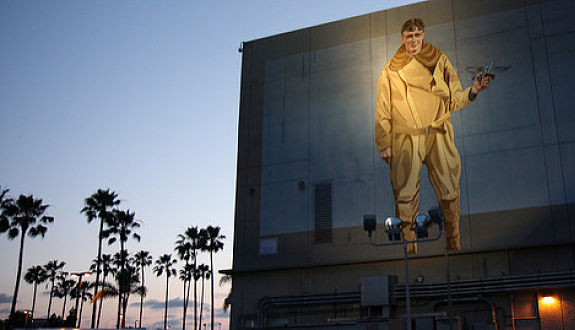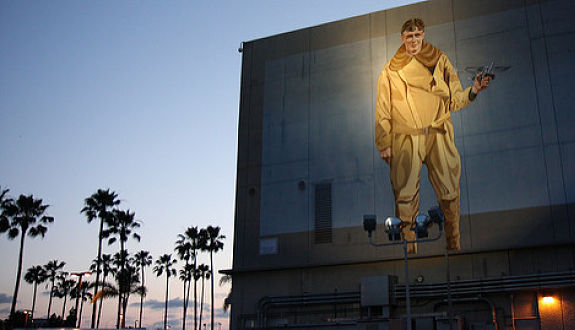Trials of the Century: The Lindbergh Baby Abduction
- by
- Oct 21, 2016
- Legal Life
- Reviewed by: Matt Riley


Charles Lindbergh Mural – San Diego Airport
Charles Lindbergh, a completely unknown air-mail pilot, flew his way into history. He was the first person to complete a solo, nonstop flight from New York City to Paris. When he landed in Paris, a crowd of about 150,000 people were there to greet him. When he finally got back to New York City, a crowd of 200,000 welcomed him back. To put that into perspective, Beyonce on average only manages to turn out 45,000 people. Lindbergh was awarded the Congressional Medal of Honor — an award usually reserved for combat veterans. He was named “Man of the Year” by the Times. The U.S. Post Office commemorated his flight with a 10-cent stamp. Lindbergh went on to use his fame to help popularize commercial aviation.
Only about five years after the historic flight, Lindbergh’s one-year old son was kidnapped. Someone brought a ladder to the Lindbergh home and snuck into the child’s room, taking the child but leaving the ladder and a ransom note at the scene.
Lindbergh tried to ransom his son back, negotiating the details through John F. Condon. Condon had publically offered $1,000 to the kidnapper if they’d turn the boy over to a Catholic priest. Someone who claimed to be the kidnapper contacted Condon and asked him to act as a go-between with Lindberg. At one point, Condon met the self-identified kidnapper, who hid his identity by staying in the shadows. About a month after the kidnapping, Lindbergh paid $50,000 in cash and gold certificates to the kidnapper, after kidnapper sent Lindbergh the boy’s pajamas. In exchange, the kidnapper promised to tell Lindbergh where he could find his son. He lied. The boy’s body was found about a week later, chewed on by animals; he had apparently died of a blow to the head.
Investigators had only one lead: the serial numbers on the cash and gold certificates were recorded before the exchange. Eventually, they traced the ransom money to Richard Hauptmann and found a further $14,000 of the ransom money in his garage.
Hauptmann was tried, convicted, and executed. But the evidence against him was thin, especially by today’s standards. Hauptmann maintained his innocence through a marathon interrogation that included a beating. We know now that exactly these techniques lead to false-confessions, which account for a quarter of the convictions in the Innocence Project’s DNA exonerations. Hauptmann also maintained his innocence even when offered a last-minute life sentence if he’d confess.
The evidence against Hauptmann included expert handwriting analysis. Now, we know that handwriting analysis is bunk. Recently, a federal judge (and my Professor) ruled that handwriting experts couldn’t offer testimony at trial because their methods are too subjective, amounting to a pseudoscience.
There was also some eye-witness testimony. Condon identified Hauptmann as the man-in-the-shadows he negotiated with. Another man said he saw Hauptmann near the scene of the crime. But we also now know that eyewitness testimony is hugely unreliable. Eyewitness testimony played a role in about 70% of the Innocence Project’s DNA exonerations.
The other evidence against Hauptmann was similarly dubious. “Experts” testified that the wood used to construct the ladder used in the kidnapping came from Hauptmann’s attic, even though Hauptmann’s fingerprints couldn’t be found on the ladder, even though some 400 prints were found.
Hauptmann’s story is that he found the money after his friend and former business partner, Isidor Fisch passed away. Many believe that it was really Fisch who kidnapped the boy. Either way, I wouldn’t be confident enough to sentence a man to death based on the evidence presented in Hauptmann’s trial.
One of the interesting takeaways about the Lindbergh kidnapping trial is that we’re only recently starting to understand just how unscientific and unreliable forensic science really is. If you’re interested in learning more, there’s a great documentary from Frontline you have to see called “The Real CSI.”
Search the Blog

Free LSAT Practice Account
Sign up for a free Blueprint LSAT account and get access to a free trial of the Self-Paced Course and a free practice LSAT with a detailed score report, mind-blowing analytics, and explanatory videos.
Learn More
Popular Posts
-
logic games Game Over: LSAC Says Farewell to Logic Games
-
General LSAT Advice How to Get a 180 on the LSAT
-
Entertainment Revisiting Elle's LSAT Journey from Legally Blonde








